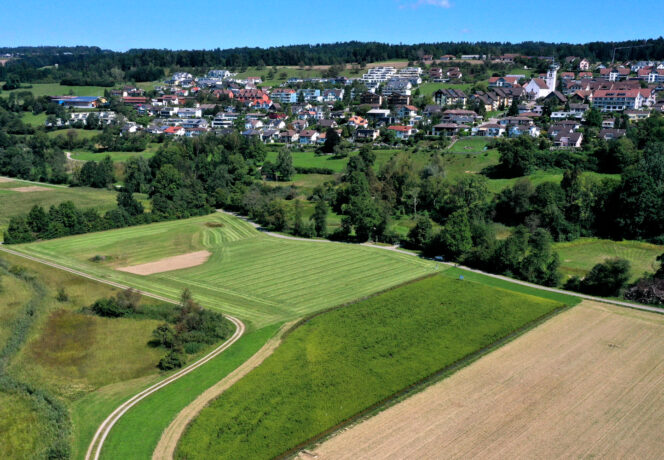Rethinking the Use of Waterlogged Wet Arable Land
Photo: Yvonne Fabian,
Agroscope
Many tile drainage systems on arable land are in need of renewal. Cantons and stakeholders will now be given a decision-making tool enabling them to assess such areas in detail and to find sustainable solutions.
Around 30% of protected crop production areas (Fruchtfolgeflächen) in Switzerland is drained so that arable and vegetable crops can be grown on it. For the older drainage systems, the question of renewal, which is associated with high costs, is increasingly being raised. At the same time, large-scale drainage has made wet habitats and their specialised flora and fauna a rarity in the agricultural landscape.
However, draining arable land does not just influence biodiversity – it exerts a complex effect on a number of processes. Depending on the location, tile drainage can increase the risk of nutrient- and plant-protection product runoff. Moreover, arable land on organic soils contains large quantities of soil carbon which continuously degrades into CO2 after drainage, thereby contributing to climate change.
Decision support for weighing up interests and priorities
As part of the ‘Wet Arable Lands’ (WAL) project, Agroscope researchers have been investigating the competing demands of productivity, climate protection, biodiversity and the protection of water bodies from nutrient and pollutant load. The relevant reports are available at www.feuchtacker.ch. On this basis, they have developed a decision-making tool geared to cantonal agricultural offices, agencies for soil protection and nature, builders, advisors and farmers. The tool is particularly helpful when dealing with tile-drainage renewal issues.
A structured process is followed to evaluate the relevant criteria and weigh up various interests and priorities. In addition to legally required criteria (watercourse corridor, waterfowl and migratory bird reserves, bog landscapes, buffer zones for wet biotopes), the key indicators of the four subject areas ‘biodiversity’, ‘water bodies’, ‘soil and greenhouse gases’ and ‘agricultural use’ are evaluated. Maps for these topics depicting the current state of knowledge and available online as GIS files are an integral part of the decision-making tool.
Available in German, French and Italian
The design of the decision-making tool was tested and refined with the help of four test cantons (Zurich, Fribourg, Vaud and Valais). The tool is now available in German and French, as of December also in Italian, and is thus usable throughout Switzerland.
The cultivation of wet rice as an alternative arable crop for wet arable lands
One possible approach to maintaining or regenerating wetlands in the agricultural landscape whilst preserving financially worthwhile production is to cultivate wet rice. An example of this are the wet-rice cultivation pilot trials that Agroscope has been conducting on the Swiss Central Plateau and in Valais in close collaboration with farmers since 2017. This partnership between research (Agroscope, HAFL), extension (Agridea) and farmers (www.nassreis.ch) has also been funded by the Swiss National Science Foundation since 2022. It is being clarified whether organic wet-rice cultivation can be supported as a region-specific biodiversity priority area with networking payments (direct payments) in 2023.
Conclusions
- Around 30% of Swiss land cropped in rotation is drained. Many tile drainage systems are in need of renewal, however. Moreover, drainage can lead to ecological problems such as biodiversity loss, pollutant runoff or CO2 emissions.
- Agroscope has developed a decision-making tool that supports cantonal agencies, builders, advisors and farmers in deciding the fate of waterlogged arable land.
- The tool provides an in-depth assessment based on the key indicators and helps with the weighing-up of various interests and priorities. Maps depicting the current state of knowledge and available online as GIS tools form an integral part of the tool.
Scientific article
Rethinking the Use of Waterlogged Wet Arable Land



